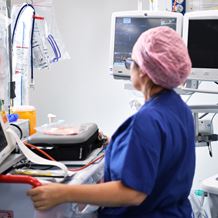What is a coronary angiogram?
A coronary angiogram, sometimes referred to as a cardiac catheterisation, is a procedure that looks closely at your coronary arteries using a special type of X-ray dye. It helps your doctor understand more about the health of your arteries and inform future treatment pathways. It can identify whether any of the blood vessels have become narrowed or blocked due to a build-up of plaque (atherosclerosis), a condition that can disrupt blood flow and prevent enough blood from reaching your heart. A coronary angiogram uses a catheter and dye to produce X-ray images of your heart and coronary arteries. It can also look for other heart problems such as heart valve disease.
What does it do?
A coronary angiogram is a diagnostic tool that helps your doctor understand more about the health of your coronary arteries. A series of X-ray images are produced which show how well blood is able to travel to your heart, and whether there are any blockages that interrupt the blood flow. In some cases, the blocked arteries may be treated in the same operation using a procedure known as coronary angioplasty. Here, the narrowed arteries are opened up using a balloon mechanism to increase the blood flow, before being removed and permanently replaced by a mesh stent.
How does it work?
A coronary angiogram investigates the blood supply to your heart. A special dye is injected into your artery (either through your wrist or groin) using a thin flexible tube known as a catheter. The dye travels to your coronary arteries where an X-ray machine takes a series of images that capture how the blood is flowing to your heart. This process identifies any blockage or narrowing of the arteries, a condition that is usually caused by a build-up of plaque and may be a sign of coronary heart disease.
Why is it performed?
Coronary angiogram is typically recommended if your doctor needs more information about your heart health. This may be as a result of another test, or because you are experiencing an onset of heart-related symptoms such as chest pain and breathlessness. The test can determine whether you have coronary artery disease, or another heart problem.
Procedure
A coronary angiogram typically takes under one hour and is usually performed as day surgery.
- After a local anaesthetic is applied to the area, a small catheter is inserted either into the wrist or groin
- The catheter is guided up to the coronary arteries using an X-ray machine
- Once the catheter is in place, a contrast dye is inserted
- As the dye travels through the catheter, a series of X-ray images are taken
- The dye will show up any areas of blockage or narrowing
- Once the pictures are complete, the catheter is removed
Recovery
After the coronary angiogram, you will spend some time in hospital under observation while you recover. You might feel slightly tired after the procedure but should return to strength within a few days. Your doctor will talk to you about your results and any necessary treatment.
What's next?
If you have been experiencing heart-related symptoms, book an appointment with our cardiac services specialist today.
Our specialists in Cardiac Services
View all specialists






